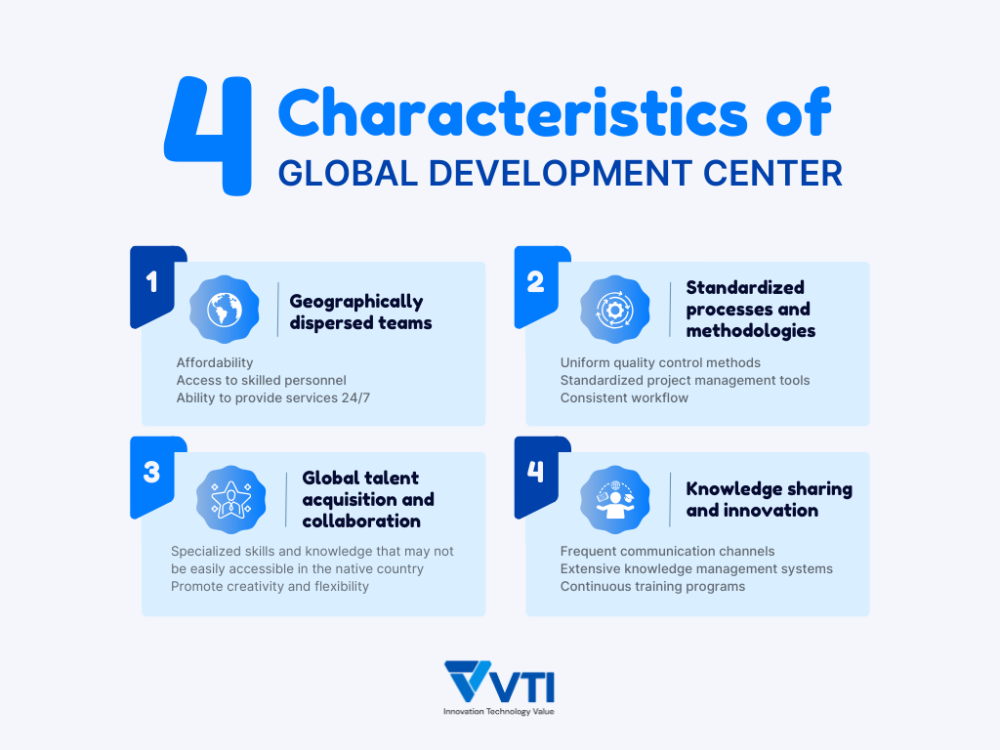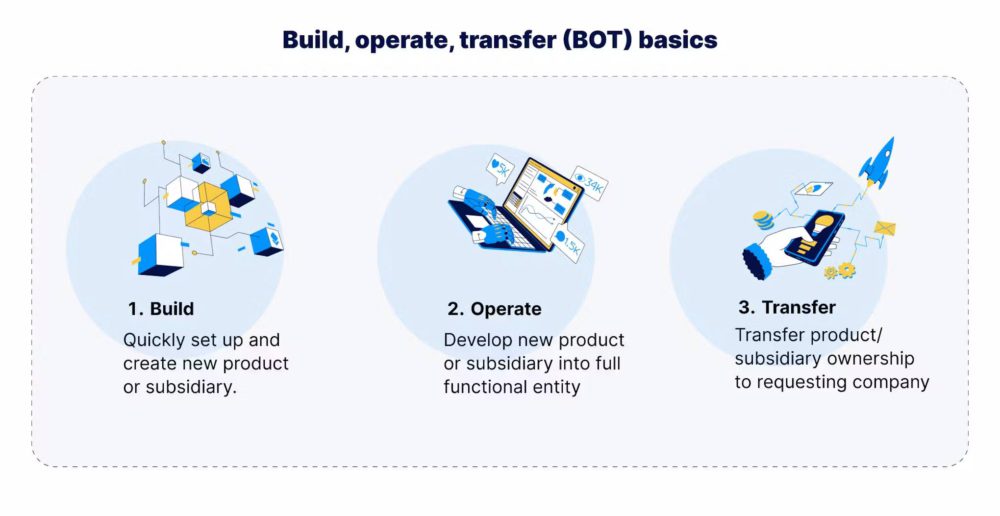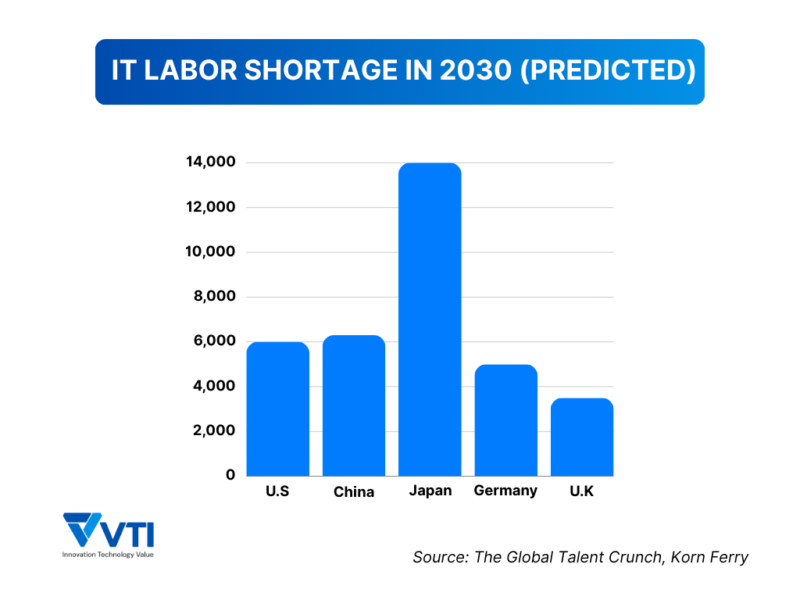In the dynamic landscape of today’s global economy, businesses are charting new territories and embracing innovative strategies to stay at the forefront of competition. As the global economy continues its rapid expansion and integration, the quest for enhanced competitiveness and wider market reach has never been more crucial. Among the myriad strategies taking center stage, the establishment of global development centers is proving to be a game-changer.
What is Global Development Center (GDC)?
A Global Development Center (GDC), also referred to as a global delivery center, are multi-location team that uses common processes, tools, and methodologies to deliver local or global projects on specific expertise and domains. It furnishes development teams with essential office infrastructure and human resources, constituting a secure and customized location for software development projects.
Essentially functioning as a remote office for organizations, a GDC enables enterprises to scale up swiftly and contributes to potential savings of up to 60% on IT execution expenses, particularly in infrastructure costs. This strategic utilization of GDCs aligns with the evolving needs of businesses, allowing them to navigate digital transformations efficiently while ensuring adaptability and cost-effectiveness.
Global Development Center’s Characteristics

- Geographically dispersed teams
Global development centers (GDCs) deliberately utilize location-specific advantages while working with teams scattered across many nations and continents. With this strategy, GDCs can benefit from things like affordability, having access to skilled personnel, and being able to provide services 24/7. GDCs maximize their resources to attain efficiency by carefully allocating teams throughout several geographies, utilizing a variety of skill sets and time zone advantages.
- Standardized processes and methodologies
Global development centers (GDCs) enforce standardized processes and techniques across their sites to maintain uniform quality and efficiency. This means that uniform quality control methods must be followed, standardized project management tools must be used, and workflows must be implemented consistently. Regardless of the teams’ geographical location, GDCs guarantee that operations are optimized and best practices are constantly implemented by implementing a standardized methodology.
- Global talent acquisition and collaboration
This model intentionally seeks out and hires people with various foreign backgrounds, expanding their pool of talent to include specialized skills and knowledge that may not be easily accessible in their native country. Having a keen understanding of cultural differences, implementing clear communication protocols, and setting clear expectations are all necessary for successful collaboration in such heterogeneous teams. GDCs can leverage a diverse workforce’s wealth of viewpoints and talents to promote creativity and flexibility. But in order to guarantee seamless cooperation, these centers must set up efficient lines of communication, explicitly state expectations, and encourage cultural awareness among team members.
- Knowledge sharing and innovation
Global development centers (GDCs) place a high priority on collaboration through the establishment of frequent communication channels, the deployment of extensive knowledge management systems, and the launch of continuous training programs. GDCs’ commitment to sharing knowledge enables them to consistently improve their procedures and provide cutting-edge solutions for their customers. Team members who often engage with one another find it easier to share ideas and insights, which fosters a dynamic and cooperative work atmosphere. Strong knowledge management system implementation guarantees that important insights and best practices are recorded and easily available throughout the company.
Build-Operate-Transfer (BOT) Model in GDC
The Build-Operate-Transfer (BOT) is deeply related to the GDC approach, a collaboration where a client company partners with an IT service provider to establish a development team or an IT service center. This collaboration often spans nearshore, onshore, and offshore phases. Here is the detailed process of the BOT model:

Source: MadDevs
- Build
The client company collaborates with an IT service provider to establish a development team or an IT service center. The location choice (nearshore, onshore, or offshore) depends on the specific project requirements. The client company and the service provider sign a detailed contract outlining project requirements, priorities, and quality standards.
The BOT is deeply related to the GDC approach, a collaboration where a client company partners with an IT service provider to establish a development team or an IT service center. This collaboration often spans nearshore, onshore, and offshore phases.
- Operate
Organizational structure and project execution: The service provider implements an organizational structure and takes responsibility for operating the project according to the client company’s requirements. Work processes and human resources are managed based on the contract’s agreed-upon criteria.
- Transfer
After a predefined period in the contract (typically several years), the project and workforce are transferred to the client company based on the agreed-upon conditions. Transfer terms include the percentage of the workforce, knowledge transfer, knowledge management, and other factors related to the client company taking over and managing the project.
The BOT contract benefits both the client company and the service provider. It enables the client company to leverage global resources efficiently and allows the service provider to scale operations and establish a presence in the international market.
What Prompts an Increasing Number of Companies to Choose Global Development Centers (GDCs)?
Prior to the pandemic, Singapore’s appeal to major tech companies was bolstered by its robust economic fundamentals and strategic positioning in the heart of Southeast Asia. Amidst the US-China “tech cold war,” Singapore has maintained its commitment to openness and innovation. However, according to a survey conducted by the human resources firm GlobalManpower, Singapore has been ranked as the third most talent-starved among 40 countries, with 84% of local companies reporting shortages in skilled personnel. This has posed a challenge to Singapore’s “hubbing” strategy aimed at attracting multinational companies.

This shortage dilemma is also rooted around the world. As the United States takes the forefront in the global economy, it is anticipated to face a substantial tech talent shortfall, specifically reaching 600,000 by 2030, particularly in the financial and IT services sectors. Other major economies like China, Japan, Germany, and the United Kingdom are also contending with significant shortages in skilled personnel.
Facing these challenges, one effective approach is to utilize global development centers, IT outsourcing, and software development services from other countries. Vietnam has emerged as a top choice due to its skilled IT workforce, cost-effectiveness, and reputation for delivering quality work. According to a report by TopDev, Vietnam has over 530,000 IT professionals, with an additional 57,000 graduates in IT-related fields each year. Establishing a GDC in Vietnam ensures the availability of qualified professionals and the ability to scale up flexibly.
Read more: Human Resources of Vietnam IT Industry in 2023 and Prediction for 2024
Differences Between Global Development Center and Offshore Development Center
| Global Development Center | Offshore Development Center | |
| Scope and Focus | Broader range of services and functions | Narrower focus on software development and IT |
| Geographic Distribution | Teams dispersed across multiple locations | Single team located in one country |
| Process and Methodology | Standardized and centralized | More flexible and adaptable |
| Cultural and Communication | Mixed between Korean and Vietnamese | It can be all Vietnamese |
Key Differences:
Scope of work: GDC tends to employ engineers with diverse experiences across various technologies and fields. On the other hand, ODC often possesses a workforce specialized in software development.
Cost: GDC may result in higher costs compared to ODC but can provide more extensive services and greater flexibility.
Risk: GDC, with teams dispersed across multiple countries, may introduce additional complexity due to time zone differences, cultural disparities, and legal issues. ODC, while relatively less prone to such problems, could be vulnerable in terms of risk dispersion due to relying on a single location.
So, which model is suitable for your business?
Choosing the appropriate center depends on your specific requirements. Generally, GDC is suitable for large-scale projects requiring diverse services and flexibility, while ODC is more fitting for smaller projects with a focus on software development.
Utilizing Our Capabilities to Cultivate High-Performance GDC Teams
Having successfully collaborated with influential Korean companies, VTI has established GDCs specializing in various fields. A notable example includes partnering with a leading IT service company in Korea to create a Cloud Global Development Center (GDC) centered on Managed Service Provider (MSP) services in Vietnam. This strategic move addresses the labor shortage and high labor costs faced by the Korean IT industry, with a remarkable cost reduction of 40% compared to utilizing Korean resources.
Equipped with robust capabilities and a total workforce of more than 1200 employees, VTI has successfully established many high-skilled GDC teams capable of scaling up to hundreds for various projects. We take pride in our extensive experience in project management, software development, and adherence to quality standards such as CMMI Dev Level 3. With BrSE teams in Singapore, Japan, and South Korea, complemented by adept project coordinators fluent in English, Japanese, Korean, and Chinese, we ensure seamless connectivity and communication.
If you need help developing a GDC in Vietnam, please contact us.
![[FREE EBOOK] Strategic Vietnam IT Outsourcing: Optimizing Cost and Workforce Efficiency](https://vti.com.vn/wp-content/uploads/2023/08/cover-mockup_ebook-it-outsourcing-20230331111004-ynxdn-1.png)




